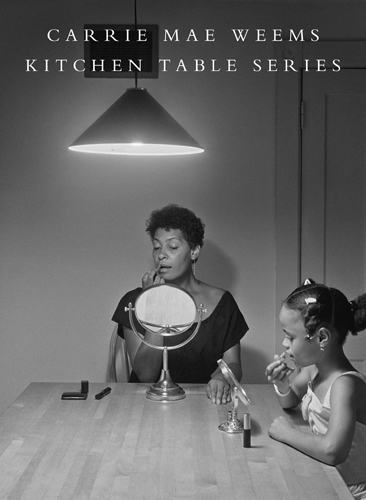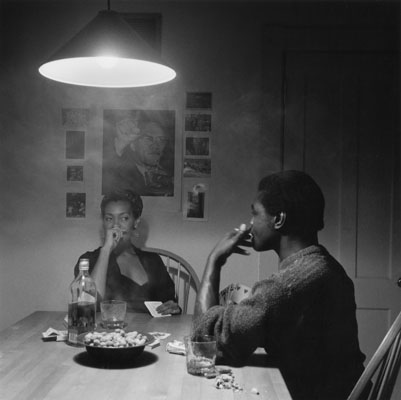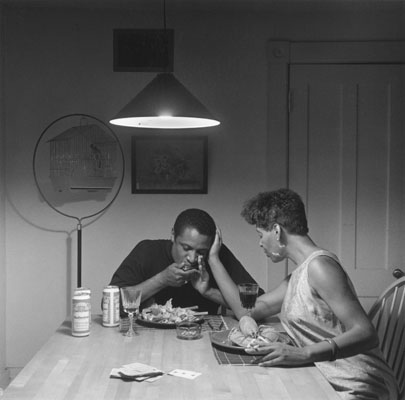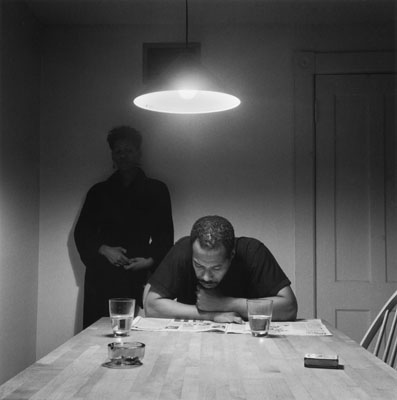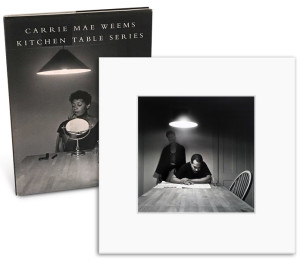
Africanah.org at 5: On September 5, 2016 we published an article on the iconic Kitchen Table Series of the American artist Carrie Mae Weems. The article was written by artist and activist Eve Sandler. For more than one reason the article was remarkable. Part of it was sung by her. That never happened before. And after.
Eve Sandler and the Kitchen Table Series of Carrie Mae Weems
KITCHEN TABLE BLUES:
Performance in the text of Carrie Mae Weems’ Kitchen Table Series
The recent publication of Kitchen Table Series, provides a welcome opportunity to revisit the pioneering and iconic series by the artist Carrie Mae Weems. The hardcover book reproduces the entire series of 20 photographs and 14 text panels. My last encounter with the Kitchen Table Series was in 2014 at the Guggenheim Museum during the course of Weems’ 30 year retrospective. Although the reproductions in the publication are no match for the richness and presence of the actual prints, the book provides an effective platform to delve deep into the series, particularly as it pertains to the text and its relationship to the images.
Created 1989-90, The Kitchen Table Series tells a domestic story of relationships between men and women, family and friends. Weems has said that the series is a “story of the battle around the family…between men and women.” Carrie Mae Weems is the protagonist and the main narrator in this intimate drama set around a kitchen table. Arresting in her on camera role, Weems performs a wide range of emotions and attitudes as she goes about her daily rituals, and as her relationship goes sour. Other characters come and go from the table: mainly her man, children and women friends.
Weems made all of the photos in her own kitchen, in her own house. All of the vignettes are set in the kitchen at the table and were shot with a single overhead light source suggestive of an interrogation room. The table and light are fixed elements. The setting is stark and the overall atmosphere is cool, perhaps even distanced. There is a film noire quality to the images and the photographs radiate the blues.
Weems has said that the images work independent of the text, and vice versa. In viewing the Kitchen Table Series in an exhibition context, I never delved heavily into the text. I grabbed onto bits and sections, but frankly real reading is difficult in the space of the museum. The book allows for a real immersion into the text narration.
The first text panel hints early on of the scope of the unfolding drama to come, when it is revealed that the lovers both love Carmen Jones. For me, it begins to suggest that the “Kitchen Table Series” actually may be a Blues Opera. The second text panel has them caught up in “that ole black magic.”
The 5th text panel incorporates an entire verse from Porgy and Bess. Our narrator has an affair and her lover suggests that “Frankie and Johnnie” may happen for real. “Frankie and Johnnie” tells the story of Frankie shooting her lover Johnnie dead when she catches him with another woman. Frankie is arrested. In some versions she is executed. By now the reader just knows this relationship is in real trouble.
Sing the blues! Sing the Kitchen Table Blues!
___________________________________________________________________
_____________________________________________________________________
TEXT FROM PANEL 10
(Song titles and lyrics are italicized)
He wasn’t working and she was, but ends meeting, ha! She felt like she was walking through a storm, like she was in a lonesome graveyard, like she had many rivers to cross, like making a way out of no way was her fate in life, like nobody knows the trouble she’d seen, like a change gotta come, like women were the mules on the world, like she needed to go tell it on a mountain, like she wanted to take a rocking chair down by the river and rock on away from here, like good morning heart ache sit down, like she needed to reach out and touch somebody’s hand, like she needed her soul rocked in the bosom of Abraham, like momma said there’d be days like this, like her man didn’t love her, like she needed him to try a little tenderness. Like maybe she’d get herself a white man, see what he’d do.

_____________________________________________________________________

